From Diversity to Homogenisation: Assessing Two Decades of Temperate Native Forest Replaced by Exotic Plantations in the Nahuelbuta Mountain Range
Abstract
1. Introduction
2. Materials and Methods
2.1. Physical and Geographical Characteristics of the Study Area
2.2. Land Use and Cover Scenarios
2.3. Analysis of Land Use and Land Cover Transitions
2.4. Spatial Analysis of Land Use and Land Cover Dynamics
2.5. Changes in Coverage and Replacement
3. Results
3.1. Land Use/Land Cover Change in the Study Watersheds
3.2. Changes in Coverage and Replacement
3.3. Landscape Metrics
4. Discussion
5. Conclusions
Author Contributions
Funding
Institutional Review Board Statement
Informed Consent Statement
Data Availability Statement
Acknowledgments
Conflicts of Interest
Appendix A
| Lebu Watershed | |||||||||
| Class | Land Use/Cover | Relative Changes (%) | |||||||
| 1999 | 2009 | 2018 | 1999–2009 | 2009–2018 | 1999–2018 | ||||
| (km2) | (%) | (km2) | (%) | (km2) | (%) | ||||
| Water bodies and channels | 0.89 | 0.14 | 0.79 | 0.12 | 0.93 | 0.14 | −0.01 | 0.02 | 0.01 |
| Temperate native forest | 481.32 | 73.38 | 424.74 | 64.75 | 289.34 | 44.11 | −8.63 | −20.64 | −29.27 |
| Exotic forest plantations | 141.73 | 21.61 | 189.51 | 28.89 | 246.98 | 37.65 | 7.28 | 8.76 | 16.05 |
| Fruit trees | 0.09 | 0.01 | 0.10 | 0.01 | 4.57 | 0.70 | 0.00 | 0.68 | 0.68 |
| Riparian vegetation and wetlands | 0.15 | 0.02 | 0.26 | 0.04 | 0.52 | 0.08 | 0.02 | 0.04 | 0.06 |
| Shrub and bush vegetation | 9.85 | 1.50 | 22.92 | 3.49 | 81.38 | 12.41 | 1.99 | 8.91 | 10.91 |
| Grasslands, pastures and annual crops | 16.01 | 2.44 | 10.60 | 1.62 | 15.48 | 2.36 | −0.82 | 0.74 | −0.08 |
| Meadows and evergreen grasslands | 1.02 | 0.16 | 0.95 | 0.15 | 0.83 | 0.13 | −0.01 | −0.02 | −0.03 |
| Bare soil and non-vegetated areas | 1.16 | 0.18 | 1.28 | 0.20 | 7.28 | 1.11 | 0.02 | 0.91 | 0.93 |
| Impermeable surfaces | 3.73 | 0.57 | 4.77 | 0.73 | 8.58 | 1.31 | 0.16 | 0.58 | 0.74 |
| Leiva Watershed | |||||||||
| Class | Land Use/Cover | Relative Changes (%) | |||||||
| 1999 | 2009 | 2018 | 1999–2009 | 2009–2018 | 1999–2018 | ||||
| (km2) | (%) | (km2) | (%) | (km2) | (%) | ||||
| Water bodies and channels | 0.05 | 0.01 | 0.13 | 0.03 | 0.10 | 0.03 | 0.02 | −0.01 | 0.01 |
| Temperate native forest | 325.11 | 83.68 | 287.56 | 74.01 | 239.52 | 61.65 | −9.67 | −12.37 | −22.03 |
| Exotic forest plantations | 21.98 | 5.66 | 46.90 | 12.07 | 67.79 | 17.45 | 6.41 | 5.38 | 11.79 |
| Fruit trees | 0.02 | 0.01 | 0.01 | 0.00 | 0.14 | 0.04 | 0.00 | 0.03 | 0.03 |
| Riparian vegetation and wetlands | 0.03 | 0.01 | 0.11 | 0.03 | 0.52 | 0.13 | 0.02 | 0.11 | 0.13 |
| Shrub and bush vegetation | 7.13 | 1.83 | 20.17 | 5.19 | 52.29 | 13.46 | 3.36 | 8.27 | 11.62 |
| Grasslands, pastures and annual crops | 28.09 | 7.23 | 27.22 | 7.00 | 24.18 | 6.22 | −0.23 | −0.78 | −1.01 |
| Meadows and evergreen grasslands | 5.93 | 1.53 | 5.40 | 1.39 | 1.33 | 0.34 | −0.14 | −1.05 | −1.18 |
| Bare soil and non-vegetated areas | 0.05 | 0.01 | 0.69 | 0.18 | 1.87 | 0.48 | 0.16 | 0.30 | 0.47 |
| Impermeable surfaces | 0.13 | 0.03 | 0.32 | 0.08 | 0.76 | 0.20 | 0.05 | 0.11 | 0.16 |
References
- Fahrig, L. Effects of Habitat Fragmentation on Biodiversity. Annu. Rev. Ecol. Evol. Syst. 2003, 34, 487–515. [Google Scholar] [CrossRef]
- Martínez-Retureta, R.; Aguayo, M.; Abreu, N.J.; Stehr, A.; Duran-Llacer, I.; Rodríguez-López, L.; Sauvage, S.; Sánchez-Pérez, J.M. Estimation of the Climate Change Impact on the Hydrological Balance in Basins of South-Central Chile. Water 2021, 13, 794. [Google Scholar] [CrossRef]
- Hernández-Sosa, M.; Aguayo, M.; Hurtado, J.; Llompart, O. The Response of the Water Cycle to Landscape Configuration and Composition in Two Chilean Basins. Environ. Sustain. Indic. 2025, 26, 100629. [Google Scholar] [CrossRef]
- Pineda, A.C. Caracterización y Análisis Multitemporal de La Dinámica Territorial de Transformación de La Estructura Ecológica Principal En La Región de La Laguna de Fúquene y Su Relación Con Los Instrumentos de Ordenamiento Territorial; Pontificia Universidad Javeriana: Colombia, CO, USA, 2021. [Google Scholar]
- Lisón, F.; Matus-Olivares, C.; Troncoso, E.; Catalán, G.; Jiménez-Franco, M.V. Effect of Forest Landscapes Composition and Configuration on Bird Community and Its Functional Traits in a Hotspot of Biodiversity of Chile. J. Nat. Conserv. 2022, 68, 126227. [Google Scholar] [CrossRef]
- Martínez-Retureta, R.; Aguayo, M.; Stehr, A.; Sauvage, S.; Echeverría, C.; Sánchez-Pérez, J.M. Effect of Land Use/Cover Change on the Hydrological Response of a Southern Center Basin of Chile. Water 2020, 12, 302. [Google Scholar] [CrossRef]
- Rodríguez-López, L.; Fuentes-Aguilera, P.; Bravo Alvarez, L.; Martínez-Retureta, R.; Duran-Llacer, I.; Bourrel, L.; Frappart, F.; Urrutia, R. Spatio-Temporal Dynamics of the Lanalhue Lake Basin in South-Central Chile. Water 2025, 17, 1114. [Google Scholar] [CrossRef]
- Hansen, M.C.; Potapov, P.V.; Moore, R.; Hancher, M.; Turubanova, S.A.; Tyukavina, A.; Thau, D.; Stehman, S.V.; Goetz, S.J.; Loveland, T.R.; et al. High-Resolution Global Maps of 21st-Century Forest Cover Change. Science 2013, 342, 850–853. [Google Scholar] [CrossRef]
- Martínez-Retureta, R.; Aguayo, M.; Abreu, N.J.; Urrutia, R.; Echeverría, C.; Lagos, O.; Rodríguez-López, L.; Duran-Llacer, I.; Barra, R.O. Influence of Climate and Land Cover/Use Change on Water Balance: An Approach to Individual and Combined Effects. Water 2022, 14, 2304. [Google Scholar] [CrossRef]
- Duran-Llacer, I.; Salazar, A.A.; Mondaca, P.; Rodríguez-López, L.; Martínez-Retureta, R.; Zambrano, F.; Llanos, F.; Frappart, F. Influence of Avocado Plantations as Driver of Land Use and Land Cover Change in Chile’s Aconcagua Basin. Land 2025, 14, 750. [Google Scholar] [CrossRef]
- Gutiérrez, J.; Altamirano, A.; Pauchard, A.; Meli, P. Proximity to Forest Plantations Is Associated with Presence and Abundance of Invasive Plants in Landscapes of South-Central Chile. NeoBiota 2024, 92, 129–153. [Google Scholar] [CrossRef]
- Altamirano, A.; Lara, A. Deforestación En Ecosistemas Templados de La Precordillera Andina Del Centro-Sur de Chile Deforestation in Temperate Ecosystems of Pre-Andean Range of South-Central Chile. Bosque 2010, 31, 53–64. [Google Scholar] [CrossRef]
- McFadden, T.N.; Dirzo, R. Opening the Silvicultural Toolbox: A New Framework for Conserving Biodiversity in Chilean Timber Plantations. For. Ecol. Manag. 2018, 425, 75–84. [Google Scholar] [CrossRef]
- Miranda, A.; Altamirano, A.; Cayuela, L.; Lara, A.; González, M. Native Forest Loss in the Chilean Biodiversity Hotspot: Revealing the Evidence. Reg. Environ. Change 2017, 17, 285–297. [Google Scholar] [CrossRef]
- Kjær, E.D.; Lobo, A.; Myking, T. The Role of Exotic Tree Species in Nordic Forestry. Scand. J. Res. 2014, 29, 323–332. [Google Scholar] [CrossRef]
- Lara, A.; Veblen, T.T. Forest Plantations in Chile: A successful model? In Afforestation: Policies, Planning and Progress; Mather, A., Ed.; Belhaber Press: London, UK, 1993; pp. 118–139. [Google Scholar]
- Wolodarsky-Franke, A.; Díaz Herrera, S. Cordillera de Nahuelbuta; Reserva Mundial de Biodiversidad WWF Chile: Valdivia, Chile, 2011. [Google Scholar]
- Otavo, S.; Echeverría, C. Progressive Fragmentation and Loss of Natural Forest Habitat in One of the World’s Biodiversity Hotspots. Sustain. For. 2021, 4, 25. [Google Scholar] [CrossRef]
- Castillo, E.J.; Ojeda, C.G.; Robles, R.F. Landscape Fragmentation at Arauco Province in the Chilean Forestry Model Context (1976–2016). Land 2022, 11, 1992. [Google Scholar] [CrossRef]
- el Jeitany, J.; Nussbaum, M.; Pacetti, T.; Schröder, B.; Caporali, E. Landscape Metrics as Predictors of Water-Related Ecosystem Services: Insights from Hydrological Modeling and Data-Based Approaches Applied on the Arno River Basin, Italy. Sci. Total Environ. 2024, 954, 176567. [Google Scholar] [CrossRef]
- Zabihi, M.; Mostafazadeh, R.; Sedaghati, I. Analyzing the Spatial Patterns and Changes in Urban Green Spaces of an under Rapid Urbanization Area through Landscape Metrics. Adv. Space Res. 2025, 76, 2779–2794. [Google Scholar] [CrossRef]
- Li, S.H.; Lin, W. A Hybrid Landscape Metric-Enhanced Cellular Automata Model (LE-CA) for Land Use/Land Cover Change Simulation: An Application to Coastal Wetlands. Ecol. Modell. 2025, 508, 111209. [Google Scholar] [CrossRef]
- Pereira, C.O.; Escanilla-Minchel, R.; González, A.C.; Alcayaga, H.; Aguayo, M.; Arias, M.A.; Flores, A.N. Assessment of Future Land Use/Land Cover Scenarios on the Hydrology of a Coastal Basin in South-Central Chile. Sustainability 2022, 14, 16363. [Google Scholar] [CrossRef]
- Kupfer, J.A. Landscape Ecology and Biogeography: Rethinking Landscape Metrics in a Post-FRAGSTATS Landscape. Prog. Phys. Geogr. 2012, 36, 400–420. [Google Scholar] [CrossRef]
- Matte, A.L.L.; Müller, S.C.; Becker, F.G. Forest Expansion or Fragmentation? Discriminating Forest Fragments from Natural Forest Patches through Patch Structure and Spatial Context Metrics. Austral Ecol. 2015, 40, 21–31. [Google Scholar] [CrossRef]
- Massmann, A.K.; Minder, J.R.; Garreaud, R.D.; Kingsmill, D.E.; Valenzuela, R.A.; Montecinos, A.; Fults, S.L.; Snider, J.R. The Chilean Coastal Orographic Precipitation Experiment: Observing the Influence of Microphysical Rain Regimes on Coastal Orographic Precipitation. J. Hydrometeorol. 2017, 18, 2723–2743. [Google Scholar] [CrossRef]
- Garreaud, R.; Falvey, M.; Montecinos, A. Orographic Precipitation in Coastal Southern Chile: Mean Distribution, Temporal Variability, and Linear Contribution. J. Hydrometeorol. 2016, 17, 1185–1202. [Google Scholar] [CrossRef]
- Peel, M.C.; Finlayson, B.L.; McMahon, T.A. Updated World Map of the Köppen-Geiger Climate Classification. Hydrol. Earth Syst. Sci. 2007, 11, 1633–1644. [Google Scholar] [CrossRef]
- Luebert, F.; Pliscoff, P. Sinopsis Bioclimática y Vegetacional de Chile; Editorial Universitaria, S.A.: Santiago, Chile, 2017; ISBN 9789561125759. [Google Scholar]
- Pliscoff Varas, P. Aplicación de Los Criterios de La Unión Internacional Para La de La Naturaleza (IUCN) Para La Evaluación de Riesgo de Los Ecosistemas Terrestres de Chile; Informe Técnico Elaborado Por Patricio Pliscoff Para El Ministerio Del Medio Ambiente: Santiago, Chile, 2015. [Google Scholar]
- Uribe, S.V.; Estades, C.F.; Radeloff, V.C. Pine Plantations and Five Decades of Land Use Change in Central Chile. PLoS ONE 2020, 15, e0230193. [Google Scholar] [CrossRef]
- Figueroa-Silva, E.; León-Aravena, J. Vocación Productiva y Realidad Productiva Territorial: El Caso de La Provincia de Arauco, Chile, 2021. Población Desarro. 2023, 29, 31–44. [Google Scholar] [CrossRef]
- Galleguillos, M.; Ceballos-Comisso, A.; Gimeno, F.; Zambrano-Bigiarini, M. CLDynamicLandCover; Zenodo: Geneva, Switzerland, 2024. [Google Scholar] [CrossRef]
- Schmidt, M. The Sankey Diagram in Energy and Material Flow Management-Part II: Methodology and Current Applications. J. Ind. Ecol. 2008, 12, 173–185. [Google Scholar] [CrossRef]
- Aplin, P.; Smith, G. Introduction to Object-Based Landscape Analysis. Int. J. Geogr. Inf. Sci. 2011, 25, 869–875. [Google Scholar] [CrossRef]
- Altamirano, A.; Aplin, P.; Miranda, A.; Cayuela, L.; Algar, A.C.; Field, R. High Rates of Forest Loss and Turnover Obscured by Classical Landscape Measures. Appl. Geogr. 2013, 40, 199–211. [Google Scholar] [CrossRef]
- Ning, F.; Wang, H.; Chien, Y.C.; Pan, H.; Ou, S.J. A Study on the Spatial and Temporal Dynamics of Landscape Spatial Patterns of Different Types of Rural Communities in Taiwan. Ecol. Indic. 2023, 157, 111227. [Google Scholar] [CrossRef]
- Polo-Akpisso, A.; Wala, K.; Soulemane, O.; Folega, F.; Akpagana, K.; Tano, Y. Assessment of Habitat Change Processes within the Oti-Keran-Mandouri Network of Protected Areas in Togo (West Africa) from 1987 to 2013 Using Decision Tree Analysis. Sci 2020, 2, 1. [Google Scholar] [CrossRef]
- Alvarez-Garreton, C.; Lara, A.; Boisier, J.P.; Galleguillos, M. The Impacts of Native Forests and Forest Plantations on Water Supply in Chile. Forests 2019, 10, 473. [Google Scholar] [CrossRef]
- Contreras, A.; Álvarez-Amado, F.; Aguilar-Gomez, M.; Campos-Quiroz, D.; Castillo, P.; Tardani, D.; Poblete-González, C.; Cortés-Aranda, J.; Godfrey, L.; Orellana-Silva, N. Land-Use Impacts on Soil Erosion: Geochemical Insights from an Urban Drinking Catchment, South-Central Chile. Water 2024, 16, 3246. [Google Scholar] [CrossRef]
- Ulyshen, M.D.; Ballare, K.M.; Fettig, C.J.; Rivers, J.W.; Runyon, J.B. The Value of Forests to Pollinating Insects Varies with Forest Structure, Composition, and Age. Curr. For. Rep. 2024, 10, 322–336. [Google Scholar] [CrossRef]
- Gazzea, E.; Battisti, A.; Marini, L. Strategies and Barriers to Reconcile Pest Management with Insect Conservation in Temperate and Boreal Forests. Curr. For. Rep. 2024, 10, 103–118. [Google Scholar] [CrossRef]
- Aburto, F.; Crovo, O.; Albornoz, M.F.; Southard, R. Effects of Native Forest Replacement to Exotic Plantations on Forest C, N, and P Pools and Dynamics in South-Central Chile. In Proceedings of the EGU General Assembly 2021, Online, 19–30 April 2021. [Google Scholar]
- Carte, L.; Hofflinger, Á.; Polk, M.H. Expanding Exotic Forest Plantations and Declining Rural Populations in La Araucanía, Chile. Land 2021, 10, 283. [Google Scholar] [CrossRef]
- Miranda, A.; Altamirano, A.; Cayuela, L.; Pincheira, F.; Lara, A. Different Times, Same Story: Native Forest Loss and Landscape Homogenization in Three Physiographical Areas of South-Central of Chile. Appl. Geogr. 2015, 60, 20–28. [Google Scholar] [CrossRef]
- Altamirano, A.; Miranda, A.; Aplin, P.; Carrasco, J.; Catalán, G.; Cayuela, L.; Fuentes-Castillo, T.; Hernández, A.; Martínez-Harms, M.J.; Peluso, F.; et al. Natural Forests Loss and Tree Plantations: Large-Scale Tree Cover Loss Differentiation in a Threatened Biodiversity Hotspot. Environ. Res. Lett. 2020, 15, 124055. [Google Scholar] [CrossRef]
- Armesto, J.J.; Rozzi, R.; Caspersen, J. Temperate Forests of North and South America. In Global Biodiversity in a Changing Environment: Scenarios for the 21st Century; Chapin, F.S., Sala, O.E., Huber-Sannwald, E., Eds.; Springer: New York, NY, USA, 2001; pp. 223–249. ISBN 978-1-4613-0157-8. [Google Scholar]
- Carrasco-Escaff, T.; Garreaud, R.; Bozkurt, D.; Jacques-Coper, M.; Pauchard, A. The Key Role of Extreme Weather and Climate Change in the Occurrence of Exceptional Fire Seasons in South-Central Chile. Weather. Clim. Extremes 2024, 45, 100716. [Google Scholar] [CrossRef]
- Fahrig, L. Patch-Scale Edge Effects Do Not Indicate Landscape-Scale Fragmentation Effects. Conserv. Lett. 2024, 17, e12992. [Google Scholar] [CrossRef]
- Salvatierra, D.; González, M.P.; Blasco, J.; Krull, M.; Araújo, C.V.M. Habitat Loss and Discontinuity as Drivers of Habitat Fragmentation: The Role of Contamination and Connectivity of Habitats. Environ. Res. 2025, 266, 120609. [Google Scholar] [CrossRef]
- Riva, F.; Koper, N.; Fahrig, L. Overcoming Confusion and Stigma in Habitat Fragmentation Research. Biol. Rev. 2024, 99, 1411–1424. [Google Scholar] [CrossRef]
- Rosa, M.R.; Brancalion, P.H.S.; Crouzeilles, R.; Tambosi, L.R.; Piffer, P.R.; Lenti, F.E.B.; Hirota, M.; Santiami, E.; Metzger, J.P. Hidden Destruction of Older Forests Threatens Brazil’s Atlantic Forest and Challenges Restoration Programs. Sci. Adv. 2021, 7, eabc4547. [Google Scholar] [CrossRef]
- Heilmayr, R.; Echeverría, C.; Lambin, E.F. Impacts of Chilean Forest Subsidies on Forest Cover, Carbon and Biodiversity. Nat. Sustain. 2020, 3, 701–709. [Google Scholar] [CrossRef]
- Roco, L.; Grebe, J.; Rosales, P.; Bravo, C. Identifying the Determinants of the Increase in Native Forests in Southern Chile. Forests 2023, 14, 1926. [Google Scholar] [CrossRef]
- Manuschevich, D.; Sarricolea, P.; Galleguillos, M. Integrating Socio-Ecological Dynamics into Land Use Policy Outcomes: A Spatial Scenario Approach for Native Forest Conservation in South-Central Chile. Land Use Policy 2019, 84, 31–42. [Google Scholar] [CrossRef]
- Nagendra, H. Opposite Trends in Response for the Shannon and Simpson Indices of Landscape Diversity. Appl. Geogr. 2002, 22, 175–186. [Google Scholar] [CrossRef]
- Fuentealba, A.; Duran, L.; Morales, N.S. The Impact of Forest Science in Chile: History, Contribution, and Challenges. Can. J. For. Res. 2021, 51, 753–765. [Google Scholar] [CrossRef]
- Bremer, L.L.; Farley, K.A. Does Plantation Forestry Restore Biodiversity or Create Green Deserts? A Synthesis of the Effects of Land-Use Transitions on Plant Species Richness. Biodivers Conserv. 2010, 19, 3893–3915. [Google Scholar] [CrossRef]
- Tomás Ibarra, J.; Cortés, J.; Petitpas, R.; Barreau, A.; Caviedes, J.; Orrego, G.; Riquelme-Maulén, W.; Altamirano, T.A. Volverse Árbol, Reconstruir La Memoria: Redes Bioculturales En Los Bosques de Pewen (Araucaria Araucana) Del Sur de Los Andes Becoming Tree, Reconstructing Memory: Biocultural Networks in Pewen (Araucaria Araucana) Landscapes of the Southern Andes. Rev. Geogr. Norte Gd. 2024, 88, 1–88. [Google Scholar] [CrossRef]
- Donoso, S.; Peña-Rojas, K.; Espinoza, C.; Badaracco, C.; Santelices-Moya, R.; Cabrera-Ariza, A. Reproductive Patterns in Araucaria Araucana Forests in the Andean Range, Chile. Ecol. Process. 2024, 13, 19. [Google Scholar] [CrossRef]
- Fabiola, B. Modernización Forestal y Percepción Medio Ambiental: Nacimiento y La Empresa INFORSA 1975-2005. Ph.D. Thesis, Universidad de Chile, Santiago, Chile, 2007. [Google Scholar]
- Echeverría, C.; Newton, A.C.; Lara, A.; Benayas, J.M.R.; Coomes, D.A. Impacts of Forest Fragmentation on Species Composition and Forest Structure in the Temperate Landscape of Southern Chile. Global Ecol. Biogeogr. 2007, 16, 426–439. [Google Scholar] [CrossRef]
- Varela, C. Evaluación Integrada de Servicios Ecosistémicos En La Cordillera de Nahuelbuta. Identificación de Oportunidades de Restauración. Master’s Thesis, Universidad de Concepción, Concepción, Chile, 2024. [Google Scholar]
- Institute World Resources Global Forest Watch. Available online: https://www.globalforestwatch.org/ (accessed on 11 August 2025).
- Fuenzalida, M.; Portales, F. Evolución Del Modelo de Producción Forestal de Monocultivo En Arauco-Malleco Para El Periodo 2001–2021. Anu. Del Confl. Soc. 2024. [Google Scholar] [CrossRef]
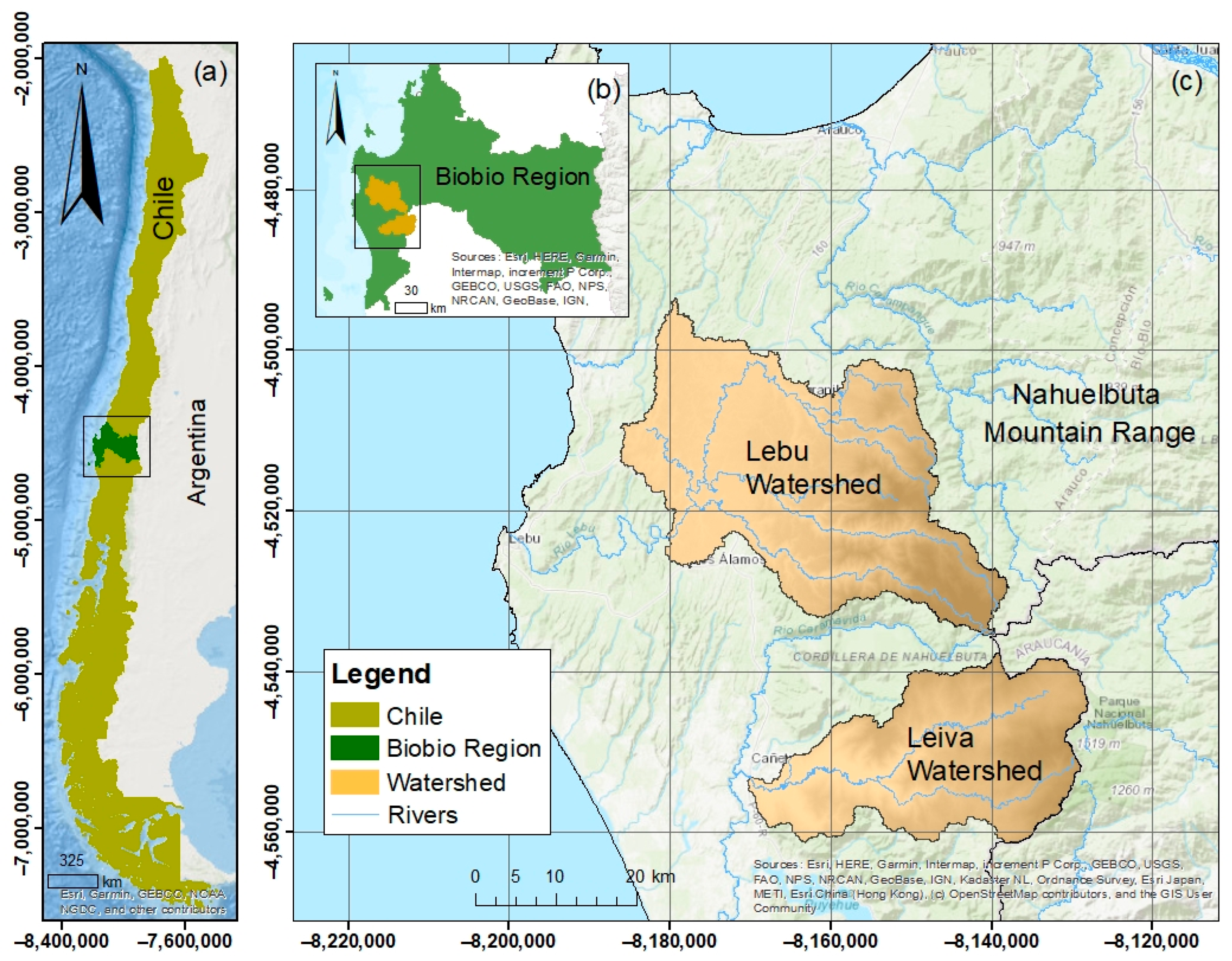
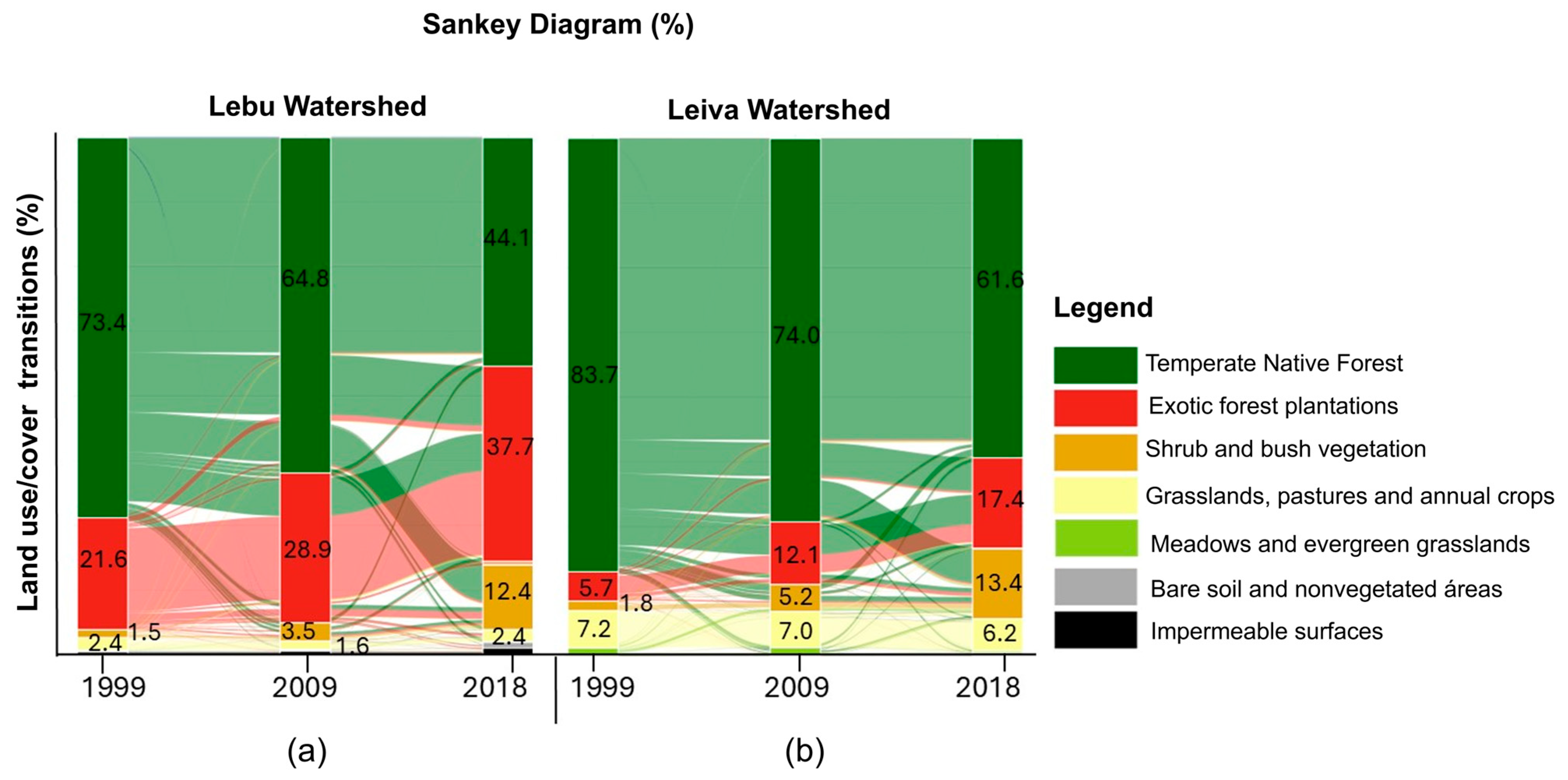
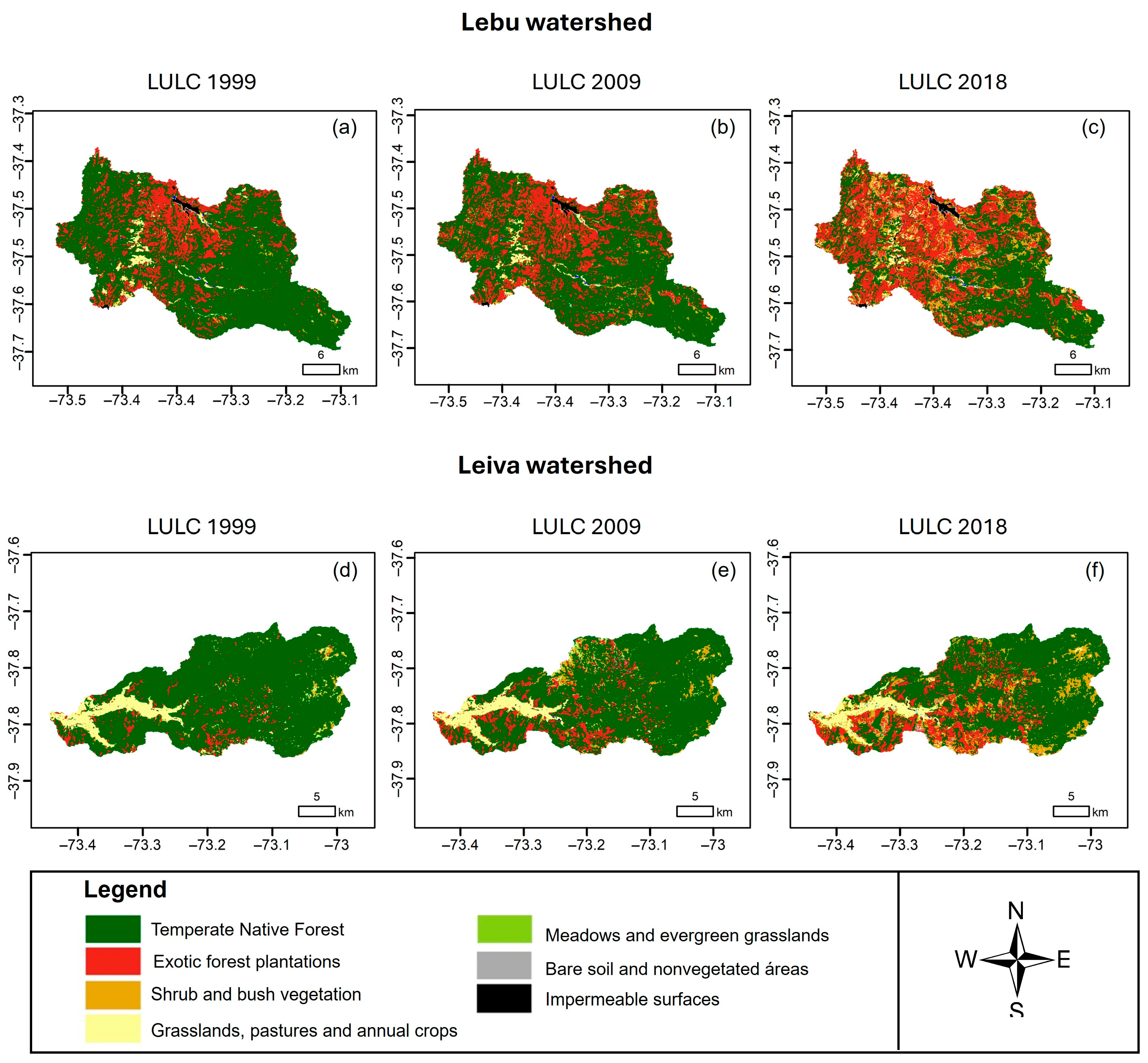
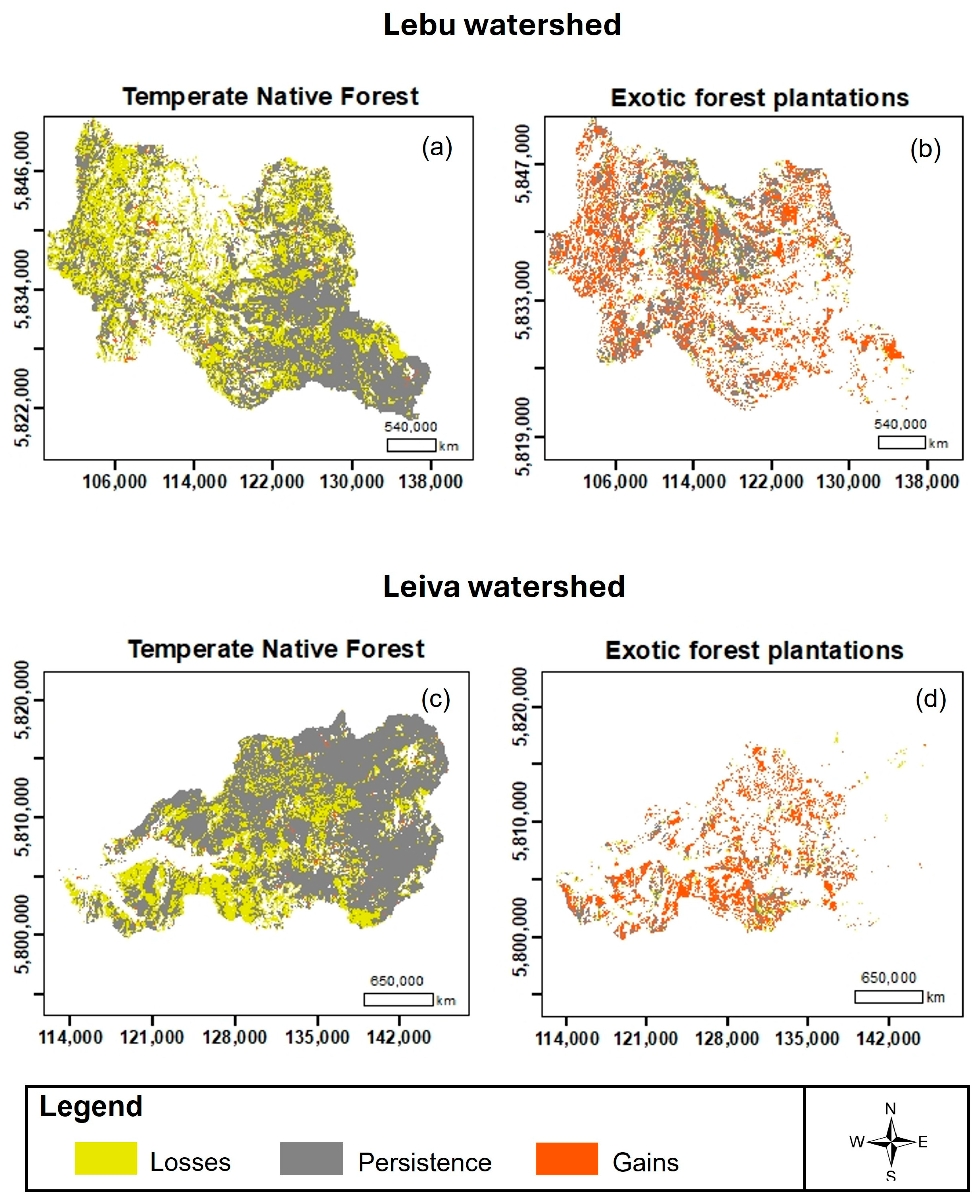
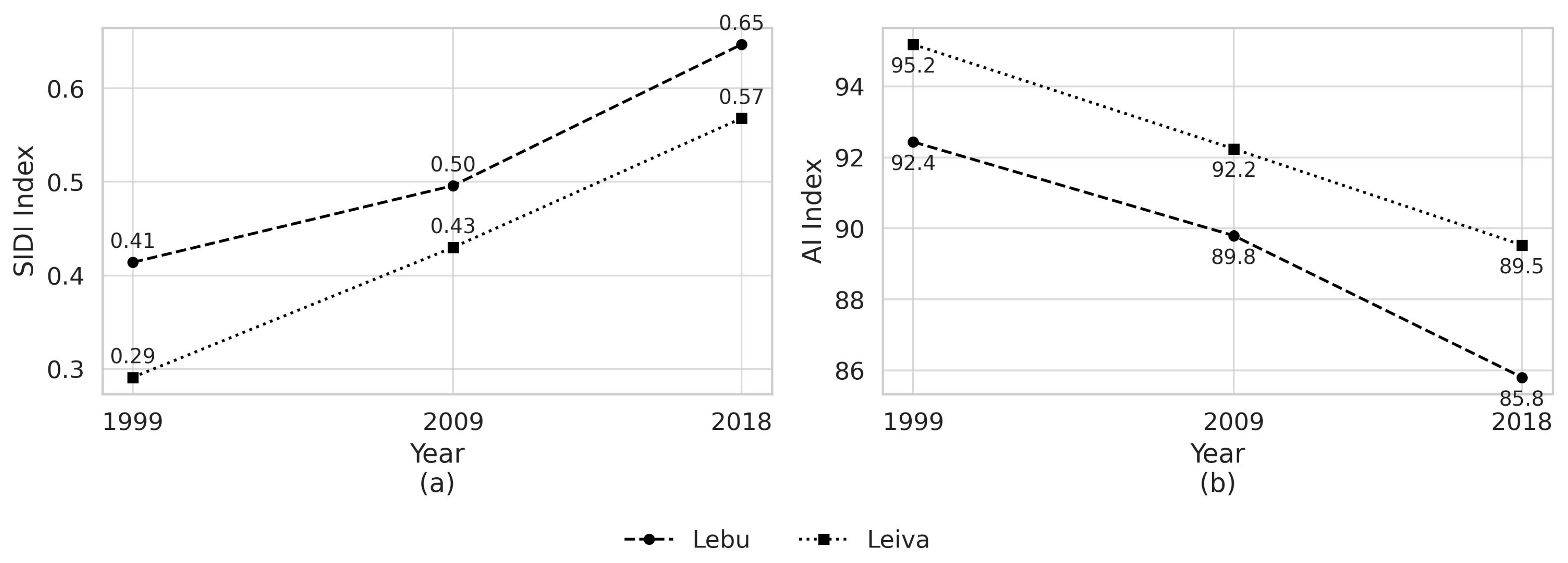
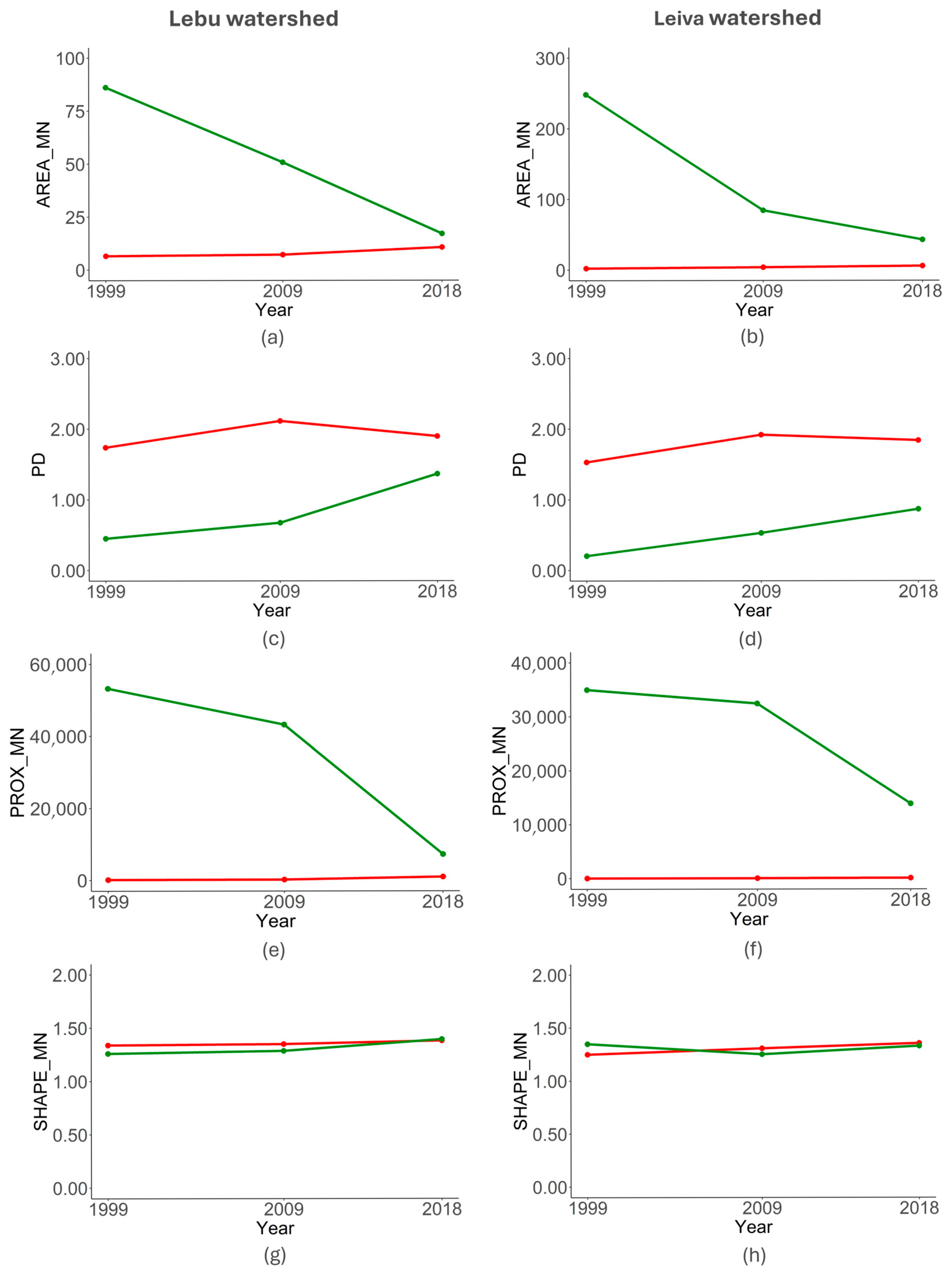
| Temperate Native Forest | Forest Plantations of Exotic Species | |||
|---|---|---|---|---|
| Class | Lebu (km2) | Leiva (km2) | Lebu (km2) | Leiva (km2) |
| Water bodies and channels | −0.11 | 0 | −0.04 | 0 |
| Beaches dunes and sandbanks | 0 | 0 | 0 | 0 |
| Mediterranean sclerophyll native forest | 0 | −0.02 | 0 | 0 |
| Temperate native forest | 0 | 0 | 123.12 | 48.99 |
| Forest plantations of exotic species | −123.12 | −48.99 | 0 | 0 |
| Fruit trees | −1.55 | −0.02 | −2.39 | −0.01 |
| Riparian vegetation and wetlands | −0.08 | −0.01 | −0.06 | −0.01 |
| Shrub and bush vegetation | −57.76 | −34.09 | −10.92 | −4.41 |
| Grasslands, pastures, and annual crops | −3.67 | −0.97 | −1.15 | 0.91 |
| Meadows and evergreen grasslands | −0.47 | 0.09 | 0.15 | 0.57 |
| Bare soil and non-vegetated areas | −4.41 | −1.56 | −1.59 | −0.19 |
| Impermeable surfaces | −0.81 | −0.03 | −1.85 | −0.05 |
| Net change | −191.98 | −85.60 | 105.27 | 45.80 |
| Lebu Watershed | Leiva Watershed | |||||
|---|---|---|---|---|---|---|
| Class | Losses (km2) | Gains (km2) | Net Change (km2) | Losses (km2) | Gains (km2) | Net Change (km2) |
| Water bodies and channels | −0.55 | 0.59 | 0.04 | −0.04 | 0.09 | 0.05 |
| Beaches, dunes, and sandbanks | −0.01 | 0.07 | 0.06 | 0.00 | 0.03 | 0.03 |
| Temperate native forest | −198.72 | 6.74 | −191.98 | −88.88 | 3.29 | −85.60 |
| Forest plantations of exotic species | −27.22 | 132.47 | 105.26 | −6.83 | 52.64 | 45.81 |
| Fruit trees | −0.08 | 4.56 | 4.48 | −0.02 | 0.14 | 0.11 |
| Riparian vegetation and wetlands | −0.12 | 0.49 | 0.37 | −0.03 | 0.52 | 0.49 |
| Shrub and bush vegetation | −5.88 | 77.42 | 71.53 | −2.04 | 47.20 | 45.16 |
| Grasslands, pastures, and annual crops | −9.92 | 9.39 | −0.53 | −6.31 | 2.40 | −3.91 |
| Meadows and evergreen grasslands | −0.94 | 0.74 | −0.20 | −5.40 | 0.80 | −4.60 |
| Bare soil and non-vegetated areas | −0.61 | 6.74 | 6.13 | −0.04 | 1.86 | 1.82 |
| Impermeable surfaces | −0.02 | 4.86 | 4.84 | 0.00 | 0.63 | 0.63 |
Disclaimer/Publisher’s Note: The statements, opinions and data contained in all publications are solely those of the individual author(s) and contributor(s) and not of MDPI and/or the editor(s). MDPI and/or the editor(s) disclaim responsibility for any injury to people or property resulting from any ideas, methods, instructions or products referred to in the content. |
© 2025 by the authors. Licensee MDPI, Basel, Switzerland. This article is an open access article distributed under the terms and conditions of the Creative Commons Attribution (CC BY) license (https://creativecommons.org/licenses/by/4.0/).
Share and Cite
Martínez-Retureta, R.; Reyes-Riveros, R.; Duran-Llacer, I.; Rodríguez-López, L.; Tinoco-Navarro, C.M.; Abreu, N.J. From Diversity to Homogenisation: Assessing Two Decades of Temperate Native Forest Replaced by Exotic Plantations in the Nahuelbuta Mountain Range. Land 2025, 14, 1648. https://doi.org/10.3390/land14081648
Martínez-Retureta R, Reyes-Riveros R, Duran-Llacer I, Rodríguez-López L, Tinoco-Navarro CM, Abreu NJ. From Diversity to Homogenisation: Assessing Two Decades of Temperate Native Forest Replaced by Exotic Plantations in the Nahuelbuta Mountain Range. Land. 2025; 14(8):1648. https://doi.org/10.3390/land14081648
Chicago/Turabian StyleMartínez-Retureta, Rebeca, Rosa Reyes-Riveros, Iongel Duran-Llacer, Lien Rodríguez-López, Clara Margarita Tinoco-Navarro, and Norberto J. Abreu. 2025. "From Diversity to Homogenisation: Assessing Two Decades of Temperate Native Forest Replaced by Exotic Plantations in the Nahuelbuta Mountain Range" Land 14, no. 8: 1648. https://doi.org/10.3390/land14081648
APA StyleMartínez-Retureta, R., Reyes-Riveros, R., Duran-Llacer, I., Rodríguez-López, L., Tinoco-Navarro, C. M., & Abreu, N. J. (2025). From Diversity to Homogenisation: Assessing Two Decades of Temperate Native Forest Replaced by Exotic Plantations in the Nahuelbuta Mountain Range. Land, 14(8), 1648. https://doi.org/10.3390/land14081648









